Research Results
1. Decoding how plants survive drought
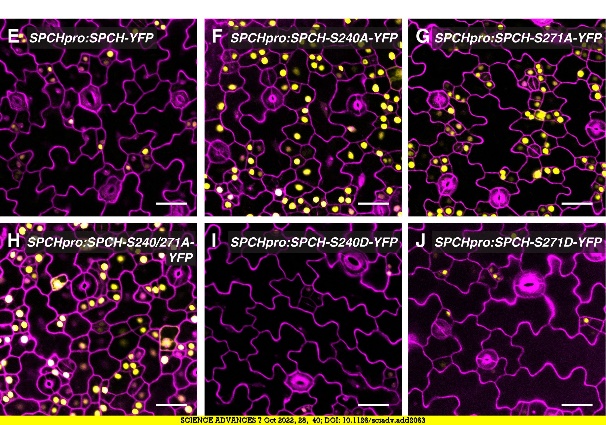 Among natural resources, water is becoming limited and land organisms, especially those that cannot move, such as plants, must adapt to periodic water shortages. In plants, most of the absorbed water is lost via transpiration—the release of water vapour through the microscopic pores called stomata. Researchers from the National University of Singapore, led by Xin Yang, have revealed how plants prevent microscopic pores from forming on their surfaces to limit water loss during drought. Stomata on the surface of leaves are important for gas exchange. During a water shortage, plants perform two stomatal reactions to save water: they close the pores of existing stomata and limit the formation of new ones. These responses, mediated by the phytohormone abscisic acid (ABA), are critical for plant adaptation to drought and are particularly important to support agriculture in a changing climate. Researchers have shown that three nuclear SnRK2 kinases in ABA signalling inhibit the initiation and proliferation of stomatal precursors in Arabidopsis.
Among natural resources, water is becoming limited and land organisms, especially those that cannot move, such as plants, must adapt to periodic water shortages. In plants, most of the absorbed water is lost via transpiration—the release of water vapour through the microscopic pores called stomata. Researchers from the National University of Singapore, led by Xin Yang, have revealed how plants prevent microscopic pores from forming on their surfaces to limit water loss during drought. Stomata on the surface of leaves are important for gas exchange. During a water shortage, plants perform two stomatal reactions to save water: they close the pores of existing stomata and limit the formation of new ones. These responses, mediated by the phytohormone abscisic acid (ABA), are critical for plant adaptation to drought and are particularly important to support agriculture in a changing climate. Researchers have shown that three nuclear SnRK2 kinases in ABA signalling inhibit the initiation and proliferation of stomatal precursors in Arabidopsis.
The researchers further show that SnRK2 acts in precursors and directly phosphorylates SPECHLESS (SPCH), a key transcription factor in stomatal initiation. Specific SPCH residues targeted by the SnRK2s, which mediate the ABA/drought-induced suppression of SPCH and stomatal production, have been identified. Importantly, the researchers also showed that plants with altered SPCH phosphorylation sites exhibited differential drought resistance. These results indicate that there is a specific ‘code’ underlying the water conservation responses of plants. “This is exciting because it suggests that by manipulating the code, we could tune the drought tolerance of crops and help optimize them under different growing conditions of traditional to urban agriculture”, says Prof On Sun Lau, the corresponding author. The authors point out that the uncoupling of the two systems offers an opportunity to evaluate the contribution of each to drought tolerance and overall growth. The ability to control individual water-related stomatal responses may enable the precise engineering of stomatal traits tailored to a variety of drought-stress conditions.
For more, see https://phys.org/news/2022-10-decoding-survive-drought.html?utm_source=nwletter&utm_medium=email&utm_campaign=daily-nwletter
Access the full paper at https://www.science.org/doi/10.1126/sciadv.add2063
2. Researchers in Japan identify genes to help crops against flooding
According to the World Bank, floods have become a global risk, affecting the lives of billions of people and causing severe property damage. Further, people are at risk of starvation owing to severe crop losses caused by floods. Now  scientists are beginning to identify the molecular processes behind how floods deprive plants of oxygen, to develop crops that can withstand floods. Newly identified genes may help protect plants from flooding, Hiroshima University researchers say, by determining the molecular processes caused by floods, which deprive plants of oxygen. Several up-and-down-regulated genes were identified by hypoxia treatment meta-analysis by Keita Tamura and Hidemasa Bono. Overlapping genes are down-regulated genes in Arabidopsis and rice. Through a meta-analysis, which also includes a re-analysis of data from other studies, the researchers discovered some common genes and related mechanisms in rice and Thale cress.
scientists are beginning to identify the molecular processes behind how floods deprive plants of oxygen, to develop crops that can withstand floods. Newly identified genes may help protect plants from flooding, Hiroshima University researchers say, by determining the molecular processes caused by floods, which deprive plants of oxygen. Several up-and-down-regulated genes were identified by hypoxia treatment meta-analysis by Keita Tamura and Hidemasa Bono. Overlapping genes are down-regulated genes in Arabidopsis and rice. Through a meta-analysis, which also includes a re-analysis of data from other studies, the researchers discovered some common genes and related mechanisms in rice and Thale cress.
They used 29 Arabidopsis and 26 rice pairs of RNA-Seq data that involved hypoxic (including submergence) and normoxic (control) treatments, and thus extracted the genes that were commonly upregulated or downregulated in most experiments. A meta-analysis revealed 40 and 19 frequently regulated genes in the two species. Several WRKY transcription factors and cinnamate-hydroxylase were frequently upregulated, but their involvement in hypoxia remains unclear. “The candidate genes identified in this study should elucidate new molecular mechanisms of plant hypoxia responses. Finally, we intend to use genome editing technology to manipulate one of the candidate genes to create flood-resistant plants,” says Bono.
For more, see https://www.isaaa.org/kc/cropbiotechupdate/article/default.asp?ID=19741
Access the full paper at https://www.mdpi.com/2075-1729/12/7/1079
3. Evidence for a new theory of genetic recombination
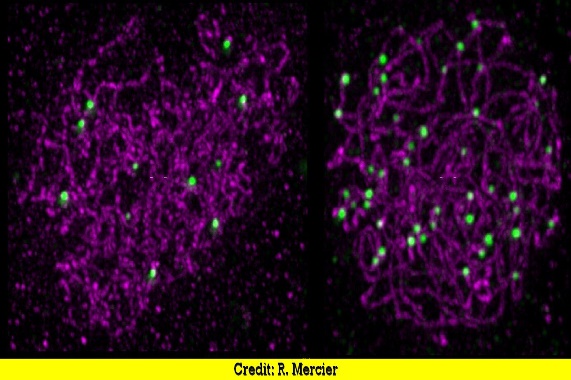 Since genes exist on the same chromosome (linked), adjacent genes are usually inherited together. However, this is not always the case. Recombination, by which pieces of DNA break up and recombine, thus producing new combinations of alleles. Such recombination creates genetic variation that reflects differences in the DNA sequences of different organisms. Mechanistically, recombination is achieved by crossing over, where homologous chromosomes touch each other, resulting in an exchange of genetic material. Crossovers have long fascinated scientists, especially plant breeders, because manipulating the crossing process provides opportunities to increase genetic variation in the offspring and to select desired combinations of alleles that increase crop productivity.
Since genes exist on the same chromosome (linked), adjacent genes are usually inherited together. However, this is not always the case. Recombination, by which pieces of DNA break up and recombine, thus producing new combinations of alleles. Such recombination creates genetic variation that reflects differences in the DNA sequences of different organisms. Mechanistically, recombination is achieved by crossing over, where homologous chromosomes touch each other, resulting in an exchange of genetic material. Crossovers have long fascinated scientists, especially plant breeders, because manipulating the crossing process provides opportunities to increase genetic variation in the offspring and to select desired combinations of alleles that increase crop productivity.
At least one chromosome per pair is required for successful sexual reproduction. A team led by Raphael Mercier of the Max Planck Institute for Plant Breeding, Cologne, Germany, has found compelling evidence to support the newly proposed model of cross-interference. Increasing the expression of the crossover protein HEI10 resulted in a significant increase in crossing over, as did the knockdown of ZYP1, a protein structure of the synaptonemal complex formed between homologous chromosomes. The marked increase in crossovers with increasing HEI10 levels fits well with the emerging model of regulating crossover counts. These data support the recently proposed model, in which HEI10 diffusion along the synaptonemal complex drives erodes the process, leading to well-spaced crossover-promoting foci, and providing a mechanism for crossover patterning. Mercier thinks that these results will help us better understand what drives the dynamics of HEI10, which in future could allow assembling combinations of beneficial alleles that were out of reach so far.
For more, see https://phys.org/news/2022-10-evidence-theory-genetic-recombination.html
Access the full paper at https://www.nature.com/articles/s41467-022-33472-w
4. Fight against wheat diseases makes further gains
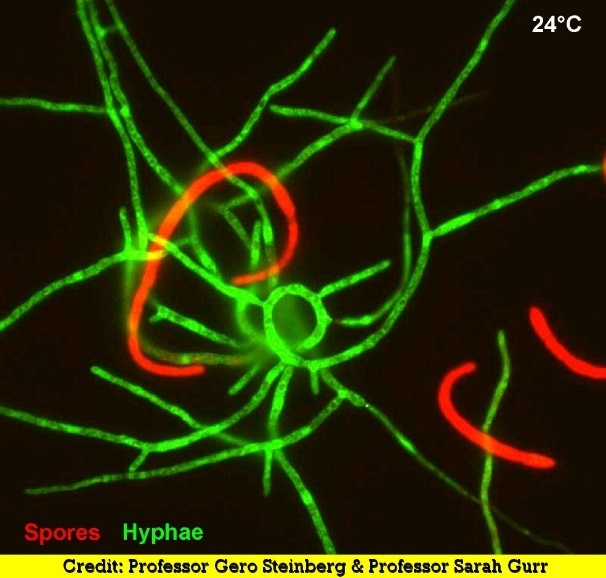 Plant diseases are major roadblocks in fighting the global hunger problem, as they cause crop losses both in the field and in storage later. Wheat is a staple for about 40% of the global population, and any reduction in its production causes major problems for feeding the world. Recently, two independent efforts generated significant results in controlling wheat diseases.
Plant diseases are major roadblocks in fighting the global hunger problem, as they cause crop losses both in the field and in storage later. Wheat is a staple for about 40% of the global population, and any reduction in its production causes major problems for feeding the world. Recently, two independent efforts generated significant results in controlling wheat diseases.
Septoria tritici blotch (caused by the fungus Zymoseptoria tritici) is wheat’s most devastating fungal disease in temperate regions worldwide. The discovery of one of the “master regulators” of the pathogenicity of the wheat pathogen, Z. tritici, is particularly important; it is an important target for the development of new control strategies against the blotch of wheat. A research team at the University of Exeter, UK, in cooperation with the University of Utrecht, the Netherlands, led by Gero Steinberg, identified a factor that regulates the invasive form of the pathogen, which gives hope for developing ways to protect the wheat crop from this economically important disease. A fluorescent dimorphic switch reporter (FDR1)-based genetic screen reveals a crucial role for the white-collar complex (WCC) in dimorphism and virulence, mediated by control of pan-strain core dimorphism genes (PCDGs) expression. In this manner, WCC integrates light with biotic and abiotic signals to control Z. tritici infection.
Although stem rusts have been infecting wheat for many centuries, the efforts of breeders and plant pathologists prevented major epidemics in the main wheat-growing regions of the world during the last 50 years of the 20th century. The emergence of rust race Ug99 gave impetus to such efforts and led to the identification of Sr35, a gene that protects against Ug99 when introduced into bread wheat. Now, researchers led by Jijie Chai and Paul Schulze-Lefert of the University of Cologne and the Max Planck Institute for Plant Breeding in Cologne, Germany, and Yuhang Chen of the Chinese Academy of Sciences, have decoded the structure of the gene. Alexander Förderer, who led the study, says: “In the structure of Sr35, we could identify parts of the protein that are important for the recognition of the effector Ug99. With this understanding, I hope we can create new NLRs that can be applied in the field to protect elite wheat crops against Ug99 and thus contribute to global food security.” These structural insights allowed researchers to generate new variants of the closely related orphan leucine-rich repeat receptors (NLRs) in wheat and barley, which recognize the effector AvrSr356 of the wheat stem rust pathogen. The results indicate that structure-based engineering of NLRs is possible to improve the resistance of wheat.
For more, see (1) https://phys.org/news/2022-09-reveals-master-fungal-infection-wheat.html?utm_source=nwletter&utm_medium=email&utm_campaign=daily-nwlet%E2%80%A6%201/; (2) https://phys.org/news/2022-09-wheat-immune-protein-resolvedimportant-tool.html?utm_source=nwletter&utm_medium=email&utm_campaign=dai%E2%80%A6%201/3
Access the full paper at (1) https://www.nature.com/articles/s41467-022-33183-2; (2) https://www.nature.com/articles/s41586-022-05231-w
5. Breakthrough in protecting bananas from Panama disease
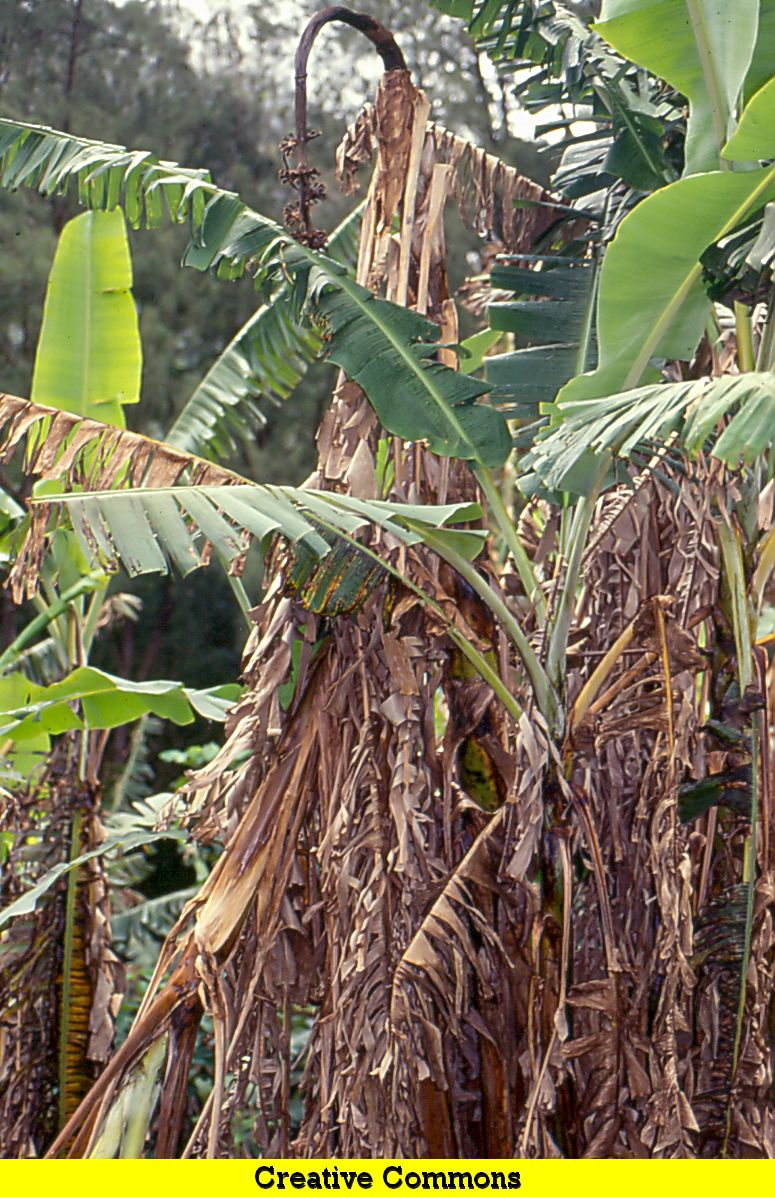 Global banana production is challenged by the Panama disease, caused by Fusarium oxysporum f.sp. cubense Tropical Race 4 (FocTR4). There are no effective fungicide-based strategies to control this soil-borne pathogen. This could be due to the insensitivity of the pathogen to fungicides and/or soil application per se. Researchers from the UK and the Netherlands, led by Gero Steinberg, assessed the effect of 12 single-site and 9 multi-site fungicides against FocTR4 and Foc Race1 (FocR1) in quantitative colony growth, and cell survival assays in purified FocTR4 macroconidia, microconidia, and chlamydospores.
Global banana production is challenged by the Panama disease, caused by Fusarium oxysporum f.sp. cubense Tropical Race 4 (FocTR4). There are no effective fungicide-based strategies to control this soil-borne pathogen. This could be due to the insensitivity of the pathogen to fungicides and/or soil application per se. Researchers from the UK and the Netherlands, led by Gero Steinberg, assessed the effect of 12 single-site and 9 multi-site fungicides against FocTR4 and Foc Race1 (FocR1) in quantitative colony growth, and cell survival assays in purified FocTR4 macroconidia, microconidia, and chlamydospores.
Researchers then focused on the current threat of Foctr4 to Cavendish banana production and compared the transcriptional responses of FocTR4 and Z. tritici to sites targeted by individual azoles and succinate dehydrogenase inhibitors (SDHIS). These experiments revealed the innate resistance of FocTR4 to all single-site fungicides, with neither azoles nor SDHIs, strobilurins or benzimidazoles, killing these spore forms. In the case of hyphae treated with fungicides, the researchers found that this innate resistance occurs in a subpopulation of “durable” cells and is not genetically inherited. A comparison of gene expression in FocTR4 and Zymoseptoria tritici grown under similar conditions showed that this response is observed only in FocTR4. In contrast, FocTR4 shows little intrinsic resistance to most multisite fungicides. On the other hand, quantitative virulence tests on soil-grown bananas showed that only captan (20 μg ml-1) and all lipophilic cations (200 μg ml-1) effectively inhibited Panama disease. These fungicides can help protect bananas from future yield losses caused by FocTR4.
For more, see https://journals.plos.org/plospathogens/article?id=10.1371/journal.ppat.1010860
6. What keeps plant roots growing toward gravity? A study identifies four genes
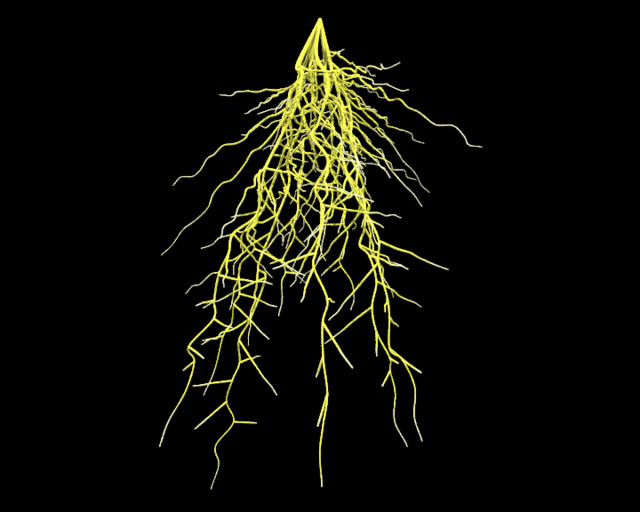 One can easily overlook what happens belowground in a corn or sorghum field, where plant root architecture plays an important role in water and nutrient acquisition, affecting drought tolerance, water-use efficiency, and sustainability. If breeders could encourage crop plant roots to grow down at a steeper angle, the crop could potentially access important resources deeper in the soil. The first step towards this goal is to study the genes involved in gravitropism and root growth in response to gravity. Edgar Spalding of the University of Wisconsin (Madison, USA) and colleagues have identified four such genes in corn and the model plant Arabidopsis.
One can easily overlook what happens belowground in a corn or sorghum field, where plant root architecture plays an important role in water and nutrient acquisition, affecting drought tolerance, water-use efficiency, and sustainability. If breeders could encourage crop plant roots to grow down at a steeper angle, the crop could potentially access important resources deeper in the soil. The first step towards this goal is to study the genes involved in gravitropism and root growth in response to gravity. Edgar Spalding of the University of Wisconsin (Madison, USA) and colleagues have identified four such genes in corn and the model plant Arabidopsis.
The researchers could map these genes to the correct region of the genome for several hundred genes, but they were still far from identifying the individual genes involved in gravitropism. Researchers previously performed the same experiment on corn with the distantly related plant Arabidopsis, and they managed to connect the genes of both species in the corresponding regions of the genome. Subsequent tests confirmed the identity of four genes that modulate root gravitropism. The new information can help us understand how gravity shapes the architecture of the root system. Although the same genes might exist in distantly related species, the order of genes in the region the trait maps to doesn’t match (e.g., UGRBZ). This question should be fundamental for the basic function of a plant, ensuring the presence of the same ancient genes in related species. With this understanding of the molecular mechanism and the identification of genes affecting gravitropism, there is the potential in changing root architecture in such a way that it can access more resources (water, nutrients) and help crops to yield better.
For more, see https://phys.org/news/2022-09-roots-gravity-genes.html?utm_source=nwletter&utm_medium=email&utm_campaign=daily-nwletter
Access the full paper at https://www.pnas.org/doi/full/10.1073/pnas.2212199119
7. The Discovery of a family of hormones may be key to increased crop yields
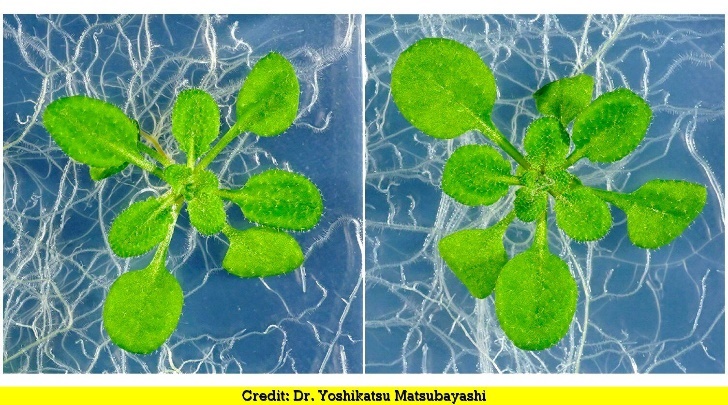 Crops often face harsh growing environments. Instead of using energy for growth, biotic (e.g., diseases) and abiotic (e.g., salinity) stresses force plants to use energy to respond to the resulting stress. This is known as the “growth-stress response trade-off”. A team of researchers from Nagoya University, Japan, led by Yoshikatsu Matsubayashi, has discovered a previously unknown pathway that regulates whether a plant uses its resources for growth or stress tolerance. Using a small flowering plant, they discovered a PLANT PEPTIDE CONTAINING SULFATED TYROSINE (PSY) family that acts like a hormone, by binding to receptors and mediating the trade-off between stress response and growth. The researchers investigated the nature of stress responses by growing plants under extremely stressful conditions, using heat and salt, and infecting them with bacteria. The researchers concluded that stressed plants stop releasing PSY, the absence of which triggers stress response genes.
Crops often face harsh growing environments. Instead of using energy for growth, biotic (e.g., diseases) and abiotic (e.g., salinity) stresses force plants to use energy to respond to the resulting stress. This is known as the “growth-stress response trade-off”. A team of researchers from Nagoya University, Japan, led by Yoshikatsu Matsubayashi, has discovered a previously unknown pathway that regulates whether a plant uses its resources for growth or stress tolerance. Using a small flowering plant, they discovered a PLANT PEPTIDE CONTAINING SULFATED TYROSINE (PSY) family that acts like a hormone, by binding to receptors and mediating the trade-off between stress response and growth. The researchers investigated the nature of stress responses by growing plants under extremely stressful conditions, using heat and salt, and infecting them with bacteria. The researchers concluded that stressed plants stop releasing PSY, the absence of which triggers stress response genes.
Instead of using its limited resources to generate a new signal, a weakened plant cell may stop the release of the PSY hormone, activating a stress response. This mechanism allows artificial regulation of the balance between stress tolerance and performance, which is a compromise. In recent years, more crops are grown in ‘factories’ (cultivation under protected areas). In crops under protected cultivation (i.e., indoors), which tend to be a low-stress environment, the stress response system that is needed to withstand the fluctuating outdoor environment is not always present. “A cultivar with reduced PSY receptor activity in factory production may lead to higher yields in these controlled environments,” says Matsubayashi.
Access the abstract at https://www.science.org/doi/10.1126/science.abq5735
Potential Crops/Technologies/Concepts
1. Multiplex gene editing rapidly customizes tomato cultivars with different fruit colours
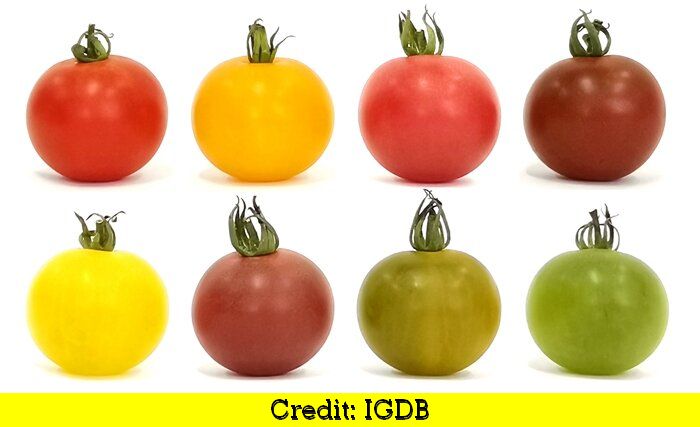 Tomato is the most popular fruit/vegetable in the world, and its colour is an important horticultural trait which influences customer preferences. Fruit colour is determined by the accumulation of various pigments, such as carotenoids and flavonoids, etc. It is a multigene trait, and it takes years to get all colour-related genes into a single genetic background through traditional breeding. A research team, led by Professor Li Chuanyou from the Chinese Academy of Sciences, Beijing, has developed a rapid breeding strategy to produce tomato lines with different coloured fruits from red fruit material, using CRISPR/Cas9-mediated multiplex gene editing. Using this strategy, researchers developed the red-fruited cultivar, Alisa Craig, into a series of tomato genotypes with different fruit colours, including yellow, brown, pink, light yellow, rose-brown, yellow-green, and light green (see picture).
Tomato is the most popular fruit/vegetable in the world, and its colour is an important horticultural trait which influences customer preferences. Fruit colour is determined by the accumulation of various pigments, such as carotenoids and flavonoids, etc. It is a multigene trait, and it takes years to get all colour-related genes into a single genetic background through traditional breeding. A research team, led by Professor Li Chuanyou from the Chinese Academy of Sciences, Beijing, has developed a rapid breeding strategy to produce tomato lines with different coloured fruits from red fruit material, using CRISPR/Cas9-mediated multiplex gene editing. Using this strategy, researchers developed the red-fruited cultivar, Alisa Craig, into a series of tomato genotypes with different fruit colours, including yellow, brown, pink, light yellow, rose-brown, yellow-green, and light green (see picture).
Through this approach, non-transgenic plants with different coloured fruits can be obtained in less than a year. The most positive aspect of this strategy is that it can preserve the characteristics of the parental variety, without affecting other important agronomic characteristics. This strategy provides a benchmark for improving multigene-controlled traits through multiple gene editing, and it has great potential for easily extending to other horticultural crops in which the fruit colour is an important agronomic trait which influences consumer preference.
Access the abstract at https://academic.oup.com/hr/advance-article/doi/10.1093/hr/uhac214/6705573?login=false
2. African wild rice genes help perennial rice halve its production cost
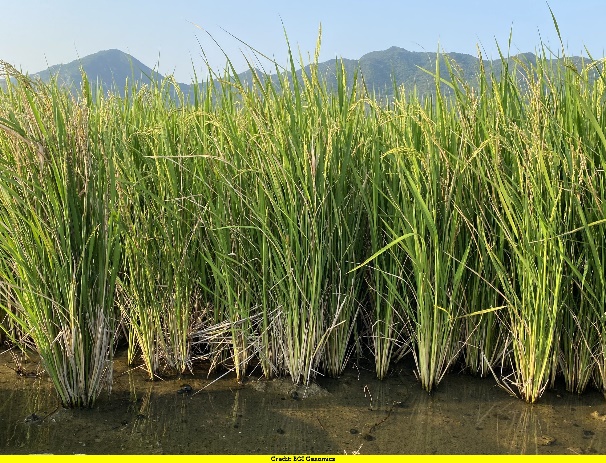 According to FAO’s The State of Food Security and Nutrition in the World 2022 report, about 670 million people are projected to be undernourished by the year 2030. Many of these will be in Africa. Against this backdrop, what are the options for agricultural scientists? One option is to focus on perennial species. Perennial rice can be harvested for many years because it contains wild rice genes and rhizomes for its propagation. Perennial rice can reduce production costs by more than 50% when compared to normal seasonal rice. Growing perennial rice not only significantly reduces production costs but also eliminates ploughing for many years, reducing the use of labour, fertilizers, and pesticides, and improving the natural properties of the soil.
According to FAO’s The State of Food Security and Nutrition in the World 2022 report, about 670 million people are projected to be undernourished by the year 2030. Many of these will be in Africa. Against this backdrop, what are the options for agricultural scientists? One option is to focus on perennial species. Perennial rice can be harvested for many years because it contains wild rice genes and rhizomes for its propagation. Perennial rice can reduce production costs by more than 50% when compared to normal seasonal rice. Growing perennial rice not only significantly reduces production costs but also eliminates ploughing for many years, reducing the use of labour, fertilizers, and pesticides, and improving the natural properties of the soil.
Perennial rice also has the advantage of high yield and quality. In Yunnan province of China, perennial rice yields 405 kg/ha, while the Chinese average is 185 kg/ha. Dr Liu of BGI Genomics believes that more such varieties can be bred, including more disease-resistant ones, and high-quality varieties that are adapted to different climates can be developed. Perennial rice was not only selected as one of FAO’s International Agricultural Innovations in 2018, but it is also one of the 29 rice varieties promoted by China’s Ministry of Agriculture and Rural Affairs in 2022. BGI’s perennial rice is well-positioned to meet this challenge, as it contains genes from the African wild rice Oryza longstaminata, which increase stress tolerance. By working with local partners, BGI can develop perennial rice varieties better suited to African agriculture, and thus it can help increase farmers’ incomes.
Download the full report at https://www.fao.org/documents/card/en/c/cc0639en
3. Use of Artificial Intelligence (AI), from developing selection models to predicting performance in the field
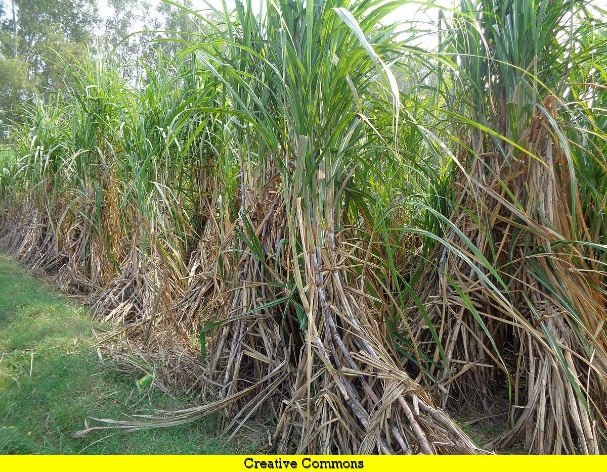 Progeny testing is a traditional method commonly used in plant breeding programmes. It relies on the phenotypic assessment of an individual’s offspring to make decisions regarding genetic selection. In many instances, this method is not very good at predicting, and it can also take several years of testing. In polyploid crops, it can become very cumbersome. Now a new report by Anete Pereira de Souza from the University of Campinas (UNICAMP), Brazil, and colleagues from many different institutes and countries, details how Artificial Intelligence (AI) can be used to create efficient models for genomic selection of sugarcane and forage grass varieties, while also predicting their field performance, based on their DNA. This is the first report about a highly efficient genomic selection method based on machine learning for polyploid plants in which cells have more than two complete sets of chromosomes. In terms of accuracy compared with traditional breeding techniques, the proposed methodology improved predictive power by more than 50%.
Progeny testing is a traditional method commonly used in plant breeding programmes. It relies on the phenotypic assessment of an individual’s offspring to make decisions regarding genetic selection. In many instances, this method is not very good at predicting, and it can also take several years of testing. In polyploid crops, it can become very cumbersome. Now a new report by Anete Pereira de Souza from the University of Campinas (UNICAMP), Brazil, and colleagues from many different institutes and countries, details how Artificial Intelligence (AI) can be used to create efficient models for genomic selection of sugarcane and forage grass varieties, while also predicting their field performance, based on their DNA. This is the first report about a highly efficient genomic selection method based on machine learning for polyploid plants in which cells have more than two complete sets of chromosomes. In terms of accuracy compared with traditional breeding techniques, the proposed methodology improved predictive power by more than 50%.
On the other end, AI can be used also to assess the quality control of the product. South Australian AI company GoMicro is developing its new grain estimation technology in Australia, paving the way for more consistent quality control and more stable grain and pulse prices. Sivam Krish, CEO of GoMicro, says the multigrain estimator gives growers in both domestic and export markets a faster and better way to accurately classify crops. The method can be used for testing more than 1,200 grains in a single sample, compared to the existing scanner-based method, which evaluates approximately 200 well-separated grains at a time. GoMicro’s grain evaluation technology is also being tested on wheat grown in India and corn in Ghana, and talks are in an advanced stage to expand the use of the evaluators with a major Indian ag-tech company for grain, corn, and soybean procurement. This method thus has the potential to reduce the risk of quality assessment for all parties in the supply chain, and it can thus help growers to receive good returns for their produce.
For more, see https://www.innovationnewsnetwork.com/plant-genomic-selection-models-to-be-created-by-artificial-intelligence/26453/ and https://phys.org/news/2022-10-artificial-intelligence-sugarcane-field.html?utm_source=nwletter&utm_medium=email&utm_campaign=daily-nwletter
Access the full paper at https://www.nature.com/articles/s41598-022-16417-7
For more, see https://phys.org/news/2022-09-ai-grain-seeds.html?utm_source=nwletter&utm_medium=email&utm_campaign=daily-nwletter
4. Insights into pathogen-host interaction offer clues to protecting crops from blast disease
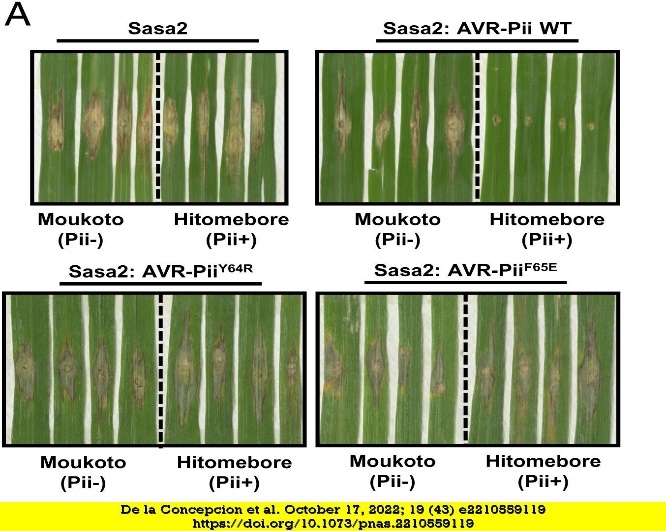
Plant diseases destroy up to 30% of annual crops, increasing global food security. Blast is a serious disease of cereal crops. Exocytosis plays an important role in plant-microbe interactions, in both pathogenesis and symbiosis. Exo70 proteins are essential components of the exocyst, a complex that mediates vesicle tethering to eukaryotic membranes. Although plant Exo70s can target pathogenic effectors, the underlying molecular mechanisms are poorly understood. Researchers at the John Innes Centre, Norwich, UK, led by Professor Mark Banfield, used protein structural analysis and revealed a tight binding mechanism, where a significant part of the effector surface is involved in the interaction with the host target. They identified a new family of Zif effectors. “These proteins may be useful in our efforts to develop new disease resistance properties against blast disease,” according to Banfield.
NLR receptors belong to a family of proteins that allow plants to detect the presence of pathogens through effector molecules, and thus mount an immune response to resist disease. A mechanism used by a fungal pathogen to promote the spread of the devastating cereal crop disease, blast, has been revealed in fine detail. Banfield’s group describes how an effector protein used by the blast fungus, Maganaporthe oryzae, binds to the rice host receptor protein Exo70. The results indicate that blast fungus ZiF effectors bind a conserved Exo70 interface to manipulate plant exocytosis and that these effectors also act as decoys for plant immune receptors, suggesting possible options for disease resistance engineering.
Access the full paper at https://www.pnas.org/doi/10.1073/pnas.2210559119
5. Scientists unravel insights on millet genotype-microbiota interaction to enhance crop adaptability and yield
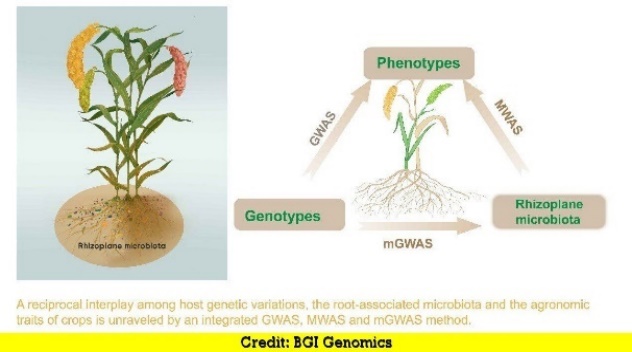
Foxtail millet, Setaria italica, is one of the oldest and most enduring crops in the world. Compared to rice and wheat, foxtail millet has excellent climate tolerance and requires less fertilizer, pesticides, and irrigation than conventional grains. Millet-based foods are also nutritionally better than those cereals. These characteristics allow this crop to play an important role in strengthening global food security. BGI (formerly Beijing Genomics Institute, now a Biotechnology company), Shenzhen, in collaboration with the Chinese Academy of Sciences, revealed a genotype-microbiome interaction network in the millet plant which contributes to its phenotypic plasticity.
Previous studies had identified key loci for early and late flowering and shock resistance in foxtail millet, but the loci associated with plant growth or yield were not known. The present study provides a comprehensive analysis of the genetic and environmental factors influencing millet growth and yield. This study combines genome-wide, microbe-wide-association studies, and microbiome-genomic methods to reveal relationships between foxtail millet genotypes, agronomic phenotypes, and rhizoplane microbiota. These research results will help to improve the productivity of millet and environmental adaptability. The microbial-mediated growth effects on foxtail millet are dependent on the host genotype, suggesting that precision management of microbiomes has great potential for engineering high-yielding cultivars in agricultural systems.
Access the full paper at https://www.nature.com/articles/s41467-022-33238-4
6. New sweetness-enhancing compounds discovered in citrus fruits
 There are many kinds of natural sweeteners in the market. Due to the high demand for healthy nutrition, it is important to research natural sweeteners used in foods that improve taste while reducing calories. Citrus fruits are considered a good potential source of non-caloric sweeteners, but so far only one sweetness modulator has been found in this most common fruit. Zhixin Wang from the Citrus Research & Education Center, University of Florida, United States, and colleagues report an efficient strategy, based on targeted metabolomics analyses, to screen sweeteners from citrus fruits. Eight sweeteners were examined, seven of which were recently identified from the genus Citrus. Surprisingly, they identified a naturally occurring ‘oxime V,’ previously known only as a synthetic compound. The concentrations of five compounds in 11 citrus cultivars or unreleased selections were compared over two years of production. The successful identification of these natural sweeteners in citrus showed the possibility of identifying significant biosynthetic pathways and then breeding new citrus cultivars containing these compounds, thus both adding flavour and reducing sugar consumption. This study also demonstrates that the proposed metabolomics-based screening strategy can expand opportunities for citrus growers and for breeding cultivars to be selected to obtain high yields of sweetener compounds that are safe and easy to source naturally.
There are many kinds of natural sweeteners in the market. Due to the high demand for healthy nutrition, it is important to research natural sweeteners used in foods that improve taste while reducing calories. Citrus fruits are considered a good potential source of non-caloric sweeteners, but so far only one sweetness modulator has been found in this most common fruit. Zhixin Wang from the Citrus Research & Education Center, University of Florida, United States, and colleagues report an efficient strategy, based on targeted metabolomics analyses, to screen sweeteners from citrus fruits. Eight sweeteners were examined, seven of which were recently identified from the genus Citrus. Surprisingly, they identified a naturally occurring ‘oxime V,’ previously known only as a synthetic compound. The concentrations of five compounds in 11 citrus cultivars or unreleased selections were compared over two years of production. The successful identification of these natural sweeteners in citrus showed the possibility of identifying significant biosynthetic pathways and then breeding new citrus cultivars containing these compounds, thus both adding flavour and reducing sugar consumption. This study also demonstrates that the proposed metabolomics-based screening strategy can expand opportunities for citrus growers and for breeding cultivars to be selected to obtain high yields of sweetener compounds that are safe and easy to source naturally.
Access the abstract at https://pubs.acs.org/doi/full/10.1021/acs.jafc.2c03515?cookieSet=1
Access a related story at https://geneticliteracyproject.org/2022/11/10/rethinking-artificial-sweeteners-fake-sugars-may-not-cause-cancer-but-theyre-not-great-for-losing-weight-either/
News:
1. UN Biodiversity Conference (COP 15)
Governments from around the world will come together in Montreal, Canada, during 7- 9 December 2022, to agree on a new set of goals that will guide global action through 2030 to halt and reverse nature loss. There are a lot of expectations; however, looking 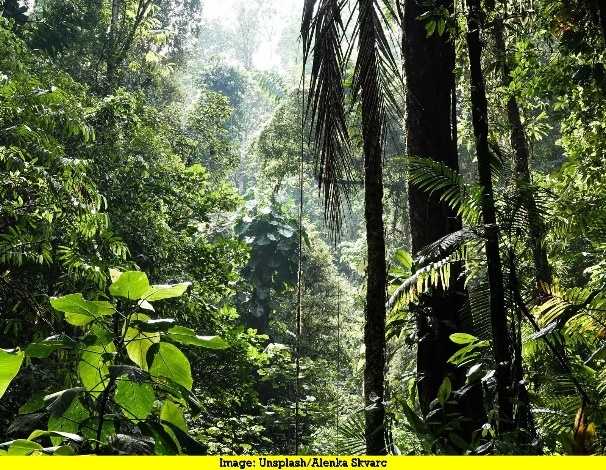 at what has been happening in recent international conferences on climate change, etc., there are many doubts as well about the real outcomes of the meeting. Nevertheless, this must be treated as an opportunity to bring back international thinking to the right track and make funding mechanisms work. The world has failed to meet all its previous UN biodiversity targets, but we cannot afford any more failures.
at what has been happening in recent international conferences on climate change, etc., there are many doubts as well about the real outcomes of the meeting. Nevertheless, this must be treated as an opportunity to bring back international thinking to the right track and make funding mechanisms work. The world has failed to meet all its previous UN biodiversity targets, but we cannot afford any more failures.
The convergence of efforts to conserve biodiversity, and to do so for tackling the climate crisis, augurs well. Tackling biodiversity is a global challenge, but it is made up of efforts at the local level. The broader picture is bleak. Unlike the climate crisis, it is hard to see any sort of roadmap out of the biodiversity crisis. Wildlife is being lost from every corner of the earth at a faster rate than ever. Successive heatwaves and droughts—like the kinds we saw this summer—are cumulatively hammering the natural world. There is thus an urgent need to adopt an equitable and comprehensive framework, matched by the resources; clear targets to address overexploitation, pollution, fragmentation, and unsustainable agricultural practices are among other things expected to be discussed and agreed upon at COP-15.
Given the complexity of the issues involved, the World Economic Forum has developed 6 charts. These six charts outline the scale of biodiversity loss, what can be done to reach the nature-positive target and explain the extent of nature loss, as well as to achieve the goal of becoming nature positive. Recovery is possible, but bending the curve for biodiversity will require ambitious targets that not only accelerate conservation and restoration but also address drivers of biodiversity loss. Crucially, while we reduce the loss of biodiversity, we would also help keep global warming below acceptable levels.
For more, see https://www.theguardian.com/environment/2022/oct/01/cop15-opportunity-save-nature-we-cant-afford-another-decade-failure-aoe and https://www.weforum.org/agenda/2022/10/nature-loss-biodiversity-wwf/
2. Old landraces contribute genetic variation to meet climate change challenges
 There are over 1750 individual genebanks in the world, storing about 7.4 million accessions, and a Global Seed Vault at Svalbard. The main justification for gene banks is eventual utilization for plant improvement. The efforts expended to preserve the diversity in crop cultivators in genebanks are rationalized by the potential role of plant genetic resources (PGR) in improving future yields, a concept whose practical implementation has fallen short of expectations. There are many reasons for this, including the fact that many plant genetic resources are in an unusable form. There is an urgent need to improve this situation. Albert Schulthess from the Institute of Plant Genetics and Crop Plant Research (IPK) Gatersleben, Germany, and colleagues from many disciplines/institutes/countries, applied a genomics-based pre-breeding strategy that does not discriminate against non-adapted germplasm for wheat improvement. Potential donors of resistance sources not yet used for breeding were identified, while the yield contribution of the PGR pre-cross was evaluated using “Elite × PGR” F1 crosses. Genomic prediction within and between genebanks identified the best parents that could be used to cross with elite cultivars. “Through extensive sequencing of old and new cultivars and valuable field data, we were able to identify potential new genetic variants for resistance to yellow rust infection,” Schulthess says.
There are over 1750 individual genebanks in the world, storing about 7.4 million accessions, and a Global Seed Vault at Svalbard. The main justification for gene banks is eventual utilization for plant improvement. The efforts expended to preserve the diversity in crop cultivators in genebanks are rationalized by the potential role of plant genetic resources (PGR) in improving future yields, a concept whose practical implementation has fallen short of expectations. There are many reasons for this, including the fact that many plant genetic resources are in an unusable form. There is an urgent need to improve this situation. Albert Schulthess from the Institute of Plant Genetics and Crop Plant Research (IPK) Gatersleben, Germany, and colleagues from many disciplines/institutes/countries, applied a genomics-based pre-breeding strategy that does not discriminate against non-adapted germplasm for wheat improvement. Potential donors of resistance sources not yet used for breeding were identified, while the yield contribution of the PGR pre-cross was evaluated using “Elite × PGR” F1 crosses. Genomic prediction within and between genebanks identified the best parents that could be used to cross with elite cultivars. “Through extensive sequencing of old and new cultivars and valuable field data, we were able to identify potential new genetic variants for resistance to yellow rust infection,” Schulthess says.
For more, see https://phys.org/news/2022-10-genetic-variation-exotic-varieties-environmentally.html?utm_source=nwletter&utm_medium=email&utm_campaign%E2%80%A6%201/3 Access the abstract at https://www.nature.com/articles/s41588-022-01189-7
For more, see https://www.miragenews.com/old-plants-might-have-new-tricks-to-improve-868705/
3. Farming community approves of crops and sustainable management practices chosen for diversifying European fields
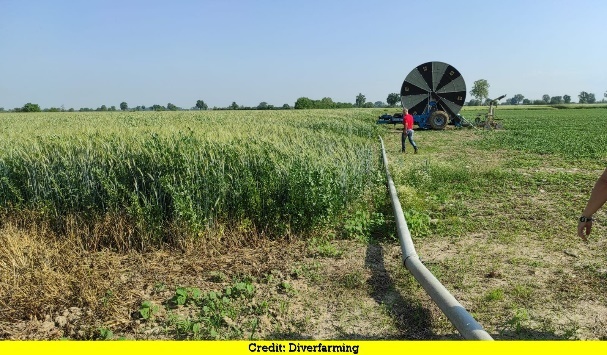 Agricultural intensification, characterized by high use of external inputs such as energy and agrochemicals, hurts the environment, causing soil degradation, loss of biodiversity, and increased greenhouse gas emissions. To reverse this alarming situation and move towards sustainable, environmentally friendly agriculture, practices such as crop rotation and reduced inputs have proven to be effective tools, supported by scientific consensus. To find out how actors involved in the agri-food system perceive the introduction of several agricultural systems and sustainable management practices in Italy, especially for cereals, the Diverfarming project team, led by Claudia Di Bene from the Research Center for Agriculture and Environment, Rome, carried out a consultation process on the benefits.
Agricultural intensification, characterized by high use of external inputs such as energy and agrochemicals, hurts the environment, causing soil degradation, loss of biodiversity, and increased greenhouse gas emissions. To reverse this alarming situation and move towards sustainable, environmentally friendly agriculture, practices such as crop rotation and reduced inputs have proven to be effective tools, supported by scientific consensus. To find out how actors involved in the agri-food system perceive the introduction of several agricultural systems and sustainable management practices in Italy, especially for cereals, the Diverfarming project team, led by Claudia Di Bene from the Research Center for Agriculture and Environment, Rome, carried out a consultation process on the benefits.
There are sustainable management strategies proposed in the project, which are not expensive, and which do not require large investments in machinery or highly trained farmers, which thus indicates a significant potential for their adoption. Training farmers in these techniques and managing diversification would be one solution to the barrier caused by a lack of education in crop rotation while incorporating this knowledge into national policies to support the adoption of sustainable agricultural practices could be an extension strategy. A very important strength for those involved is that individual plants and crops adapted to local soil and climatic conditions, which are widely known by farmers, have already been selected for the crop rotation and multiple cultivations of cereals and tomatoes.
Access the full paper at https://www.frontiersin.org/articles/10.3389/fenvs.2022.861225/full
4. Organic farming is not monolithic
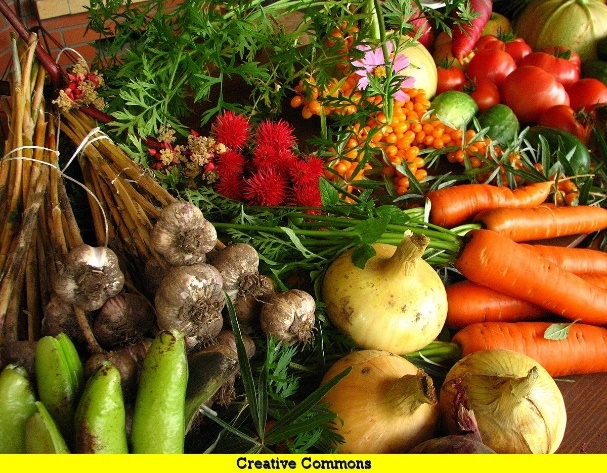 According to the Environmental Working Group (EWG), American consumers spent a total of $20 billion on organic fruits and vegetables, fresh and frozen, in 2020, and organic products now account for 15% of all fruits and vegetables sold in the United States. Organic farming is not just about family farms and farmers anymore, new research by Jeffrey Liebert and colleagues from the School of Integrative Plant Science, Cornell University, Ithaca, USA, shows. Organic agriculture outperforms conventional agriculture in several sustainability metrics, in part due to the wider use of agroecological practices. However, the increased shift from large farms to the organic sector has raised concerns about “traditionalism” over the substitution of production inputs, simplification of the agricultural ecosystem, and other changes. As decisions about management practices can lead to environmental sustainability, policy should support small and medium-sized farms that already use desirable agroecological practices, encouraging more such agroecological practices on larger farms. A small farmer does not have access to larger markets and should be able to sell in his locality.
According to the Environmental Working Group (EWG), American consumers spent a total of $20 billion on organic fruits and vegetables, fresh and frozen, in 2020, and organic products now account for 15% of all fruits and vegetables sold in the United States. Organic farming is not just about family farms and farmers anymore, new research by Jeffrey Liebert and colleagues from the School of Integrative Plant Science, Cornell University, Ithaca, USA, shows. Organic agriculture outperforms conventional agriculture in several sustainability metrics, in part due to the wider use of agroecological practices. However, the increased shift from large farms to the organic sector has raised concerns about “traditionalism” over the substitution of production inputs, simplification of the agricultural ecosystem, and other changes. As decisions about management practices can lead to environmental sustainability, policy should support small and medium-sized farms that already use desirable agroecological practices, encouraging more such agroecological practices on larger farms. A small farmer does not have access to larger markets and should be able to sell in his locality.
For more, see https://www.acsh.org/news/2022/08/16/organic-farming-not-monolithic-16492
Access the abstract at https://www.nature.com/articles/s41477-022-01191-1#citeas
5. Effective international collaboration to breed fungus-resistant cotton
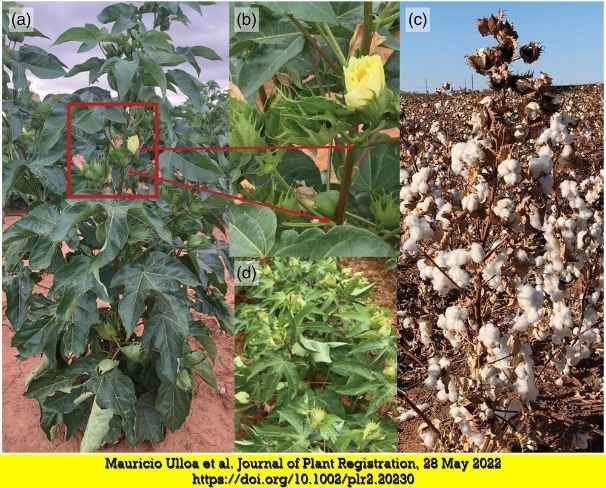 Cotton is an important crop grown around the world, as it is in countries like the United States and Uzbekistan. As Race 4 of the fusarium wilt fungus began to damage cotton production in both countries, their scientists came together for innovative research collaboration. The fungus has impacted the production of Pima cotton, a specific kind of cotton, in parts of California for nearly two decades.
Cotton is an important crop grown around the world, as it is in countries like the United States and Uzbekistan. As Race 4 of the fusarium wilt fungus began to damage cotton production in both countries, their scientists came together for innovative research collaboration. The fungus has impacted the production of Pima cotton, a specific kind of cotton, in parts of California for nearly two decades.
The United States Department of Agriculture, Uzbek scientists, some American universities, and others in the cotton industry have come together to help cotton farmers. Research teams have developed new disease-resistant Pima cotton germlines by crossing cultivars from the Uzbekistan and USDA cotton germplasm collections.
“We can use the resulting resistant gamete lines and cross them with varieties of the seed company. This reduces farmers’ economic losses in cotton production and allows them to use new and more resistant varieties,” says Mauricio Ulloa, the first author of the publication.
Access the full paper at https://acsess.onlinelibrary.wiley.com/doi/10.1002/plr2.20230
6. Models developed in collaborative work to predict locust outbreaks
Global climate change will exacerbate crop losses due to many negative effects and one such is from insect pests, threatening food security. It is important to predict where crop losses will occur and to date, scientists 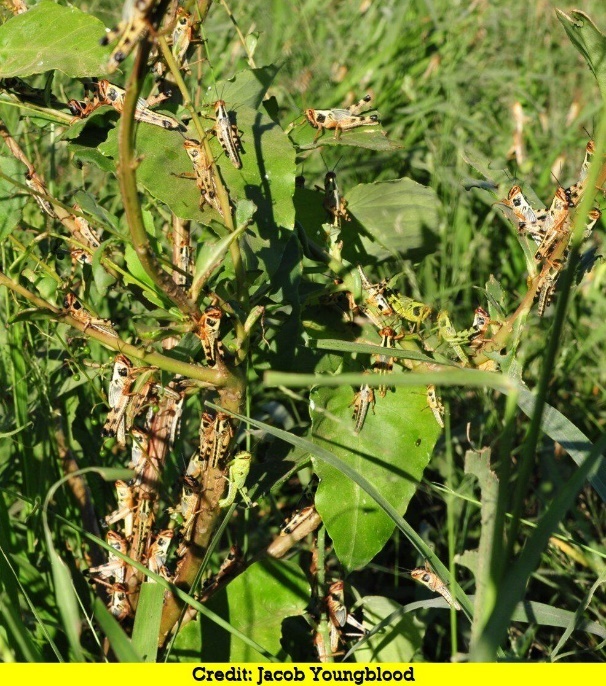 have used correlative models of species distributions. But such models are not dependable when extrapolated to future environments. To minimize extrapolation, a diverse group of researchers (including physiologists, ecologists, entomologists, and farmers) from Argentina, Bolivia, Paraguay, and the USA, led by Jacob Youngblood of Arizona State University, Tempe, Arizona, USA, developed mechanistic and hybrid models that explicitly capture range-limiting processes. Researchers explored how incorporating mechanisms altered the projected impacts of climate change for an agricultural pest, the South American locust (Schistocerca cancellation). “Understanding the biology of locusts and being able to predict when and where outbreaks will occur is a key piece of the puzzle that we have surprisingly little researched on this challenge globally. (Our) collaboration in building these models is an important advance in biology and food safety,” says Arianne Cease, a co-author of the publication.
have used correlative models of species distributions. But such models are not dependable when extrapolated to future environments. To minimize extrapolation, a diverse group of researchers (including physiologists, ecologists, entomologists, and farmers) from Argentina, Bolivia, Paraguay, and the USA, led by Jacob Youngblood of Arizona State University, Tempe, Arizona, USA, developed mechanistic and hybrid models that explicitly capture range-limiting processes. Researchers explored how incorporating mechanisms altered the projected impacts of climate change for an agricultural pest, the South American locust (Schistocerca cancellation). “Understanding the biology of locusts and being able to predict when and where outbreaks will occur is a key piece of the puzzle that we have surprisingly little researched on this challenge globally. (Our) collaboration in building these models is an important advance in biology and food safety,” says Arianne Cease, a co-author of the publication.
Access the abstract at https://esajournals.onlinelibrary.wiley.com/doi/10.1002/ecm.1550
7. Researchers reorient monocultures to intercropping in just two generations
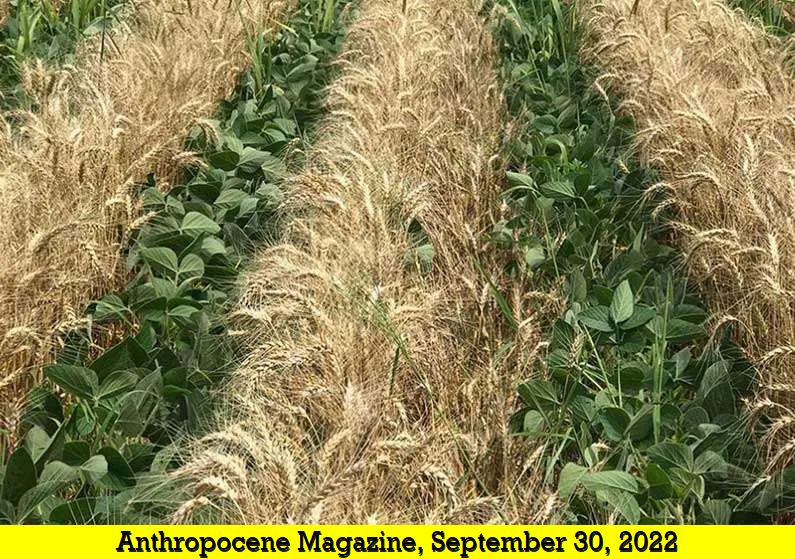
A research team led by Laura Stefan from the Institute of Agricultural Sciences in Zurich, Switzerland, investigated if and how crops adapt to the diversity of surrounding plants over generations. The experiments showed that the interaction between species that were tested changed: competition between plants decreased or increased when the plants were grown next to the same plants that their parents had grown in the previous two generations. This study provides the first empirical evidence of the potential of parental diversity to influence plant-plant interactions, species complementarity, and thus the potential ecosystem functioning of subsequent generations in annual cropping systems.
Access the abstract at https://elifesciences.org/articles/77577
Events (July 2023):
1. ICABES 2023: International Conference on Agriculture, Biology and Environmental Sciences

03-04 July 2023, Prague, Czechia
For more, see
https://waset.org/agriculture-biology-and-environmental-sciences-conference-in-july-2023-in-prague
2. ICBDPA 2023: International Conference on Big Data in Precision Agriculture

06-07 July 2023, Bali, Indonesia
For more, see https://waset.org/big-data-in-precision-agriculture-conference-in-july-2023-in-bali
3. ICCASD 2023: International Conference on Conservation Agriculture and Sustainable Development

10-11 July 2023, Copenhagen, Denmark
For more, see https://waset.org/conservation-agriculture-and-sustainable-development-conference-in-july-2023-in-copenhagen
4. ICICTE 2023: International Conference on ICT and Environment

17-18 July 2023, Rome, Italy
For more, see https://waset.org/ict-and-environment-conference-in-july-2023-in-rome
5. ICABF 2023: International Conference on Agricultural Biotechnology and Fertilisers

24-25 July 2023, Zurich, Switzerland
For more, see https://waset.org/agricultural-biotechnology-and-fertilisers-conference-in-july-2023-in-zurich
Other Topics of Interest
1. More biodiversity opportunities for more resilient greenhouse crops
For more, see https://www.hortidaily.com/article/9464497/more-biodiversity-opportunity-for-more-resilient-greenhouse-crops/
2. Climatarian, flexitarian, vegetarian, vegan: Which diet is best for the planet? (And what do they mean?)
For more, see https://ideas.ted.com/which-diet-is-better-for-climate-change-vegan-vegetarian-climatarian-flexitarian/?ref=refind
3. Ethanol helps plants better tolerate heat stress
For more, see https://phys.org/news/2022-09-ethanol-tolerate-stress.html?utm_source=nwletter&utm_medium=email&utm_campaign=daily-nwletter
Access the abstract at https://link.springer.com/article/10.1007/s11103-022-01291-8
4. Study Finds Sorghum Genetic Loci Influencing Composition, Function of Human Gut Microbes
For more, see https://www.nature.com/articles/s41467-022-33419-1
5. Some plants can short-circuit the toxic effects of metals. Now scientists are trying to harness their power
6. ‘Iconic’ plant family at risk: Scientists estimate more than half of palm species may be threatened with extinction
7. Climate change is turning trees into gluttons
For more, see https://phys.org/news/2022-09-climate-trees-gluttons.html?utm_source=nwletter&utm_medium=email&utm_campaign=daily-nwletter
8. In a first-ever, a team of Indian scientists complete genome sequencing of pomegranate, the wonder fruit
9. Do plants have a microbiome?
For more, see https://phys.org/news/2022-10-microbiome.html?utm_source=nwletter&utm_medium=email&utm_campaign=daily-nwletter
10. How farms could help defend the Earth’s own microbiome
11. Scientists test the efficacy of alternate insecticidal gene for cotton
For more, see https://www.isaaa.org/kc/cropbiotechupdate/article/default.asp?ID=19789 Access the abstract at https://link.springer.com/article/10.1007/s11033-022-07824-0
12. Viewpoint: Regenerative farming and Big Ag — Organic agriculture is no longer just ‘family farms’
For more, see https://geneticliteracyproject.org/2022/10/06/organic_farms/?utm_source=jeeng
13. Plant hormones and crop quality
14. How farmers could fertilize more efficiently
Access the abstract at https://www.cell.com/trends/plant-science/fulltext/S1360-1385(22)00222-9?_returnURL=https%3A%2F%2Flinkinghub.Elsevier.com%2Fretrieve%2Fpii%2FS1360138522002229%3Fshowall%3Dtrue
15. Global hotspots for soil conservation are poorly protected
Access the abstract at https://www.nature.com/articles/s41586-022-05292-x
16. Fertilizers cause more than 2% of global emissions
Access the full paper at https://www.nature.com/articles/s41598-022-18773-w
17. A new route to evolution: How DNA from our mitochondria works its way into our genomes
Access the full paper at https://www.nature.com/articles/s41586-022-05288-7
18. How climate change influences paddy soil nitrogen pool in northeastern China
Access the abstract at https://www.sciencedirect.com/science/article/abs/pii/S0168192322003045?via%3Dihub
19. Short-term plant-soil feedback experiments fall short in predicting the competition outcome of a long-term field experiment
Access the abstract at https://esajournals.onlinelibrary.wiley.com/doi/10.1002/ecy.3883
20. Studies on weed hosts of tomato brown rugose fruit virus
For more, see https://www.hortidaily.com/article/9465146/studies-on-weed-hosts-of-tomato-brown-rugose-fruit-virus/
Access the full paper at https://www.mdpi.com/2223-7747/11/17/2287
21. Scientists peel back ancient layers of banana DNA to reveal ‘mystery ancestors’
Access the full paper at https://www.frontiersin.org/articles/10.3389/fpls.2022.969220/full
22. Novel rice mutant ‘low grain weight’ affects grain size by regulating GW7 expression
Access the full paper at https://www.frontiersin.org/articles/10.3389/fpls.2022.997624/full
23. Researchers identify genes potentially responsible for sugarcane’s resistance to pests, cold and drought
Access the full paper at https://www.frontiersin.org/articles/10.3389/fpls.2022.923069/full
24. Food deficits in Africa will grow in a warmer world
Access the full paper at https://agupubs.onlinelibrary.wiley.com/doi/10.1029/2022EF002651
25. Documenting the world’s crop diversity and making it available Towards zero hunger in Africa: Five steps to achieve food security
For more, see https://phys.org/news/2022-10-hunger-africa-food.html?utm_source=nwletter&utm_medium=email&utm_campaign=daily-nwletter
26. HTBt cotton and GM mustard set to get GEAC approval; first for any GM crop in 20 years
